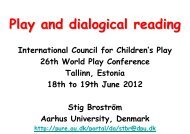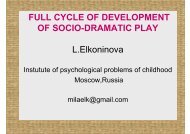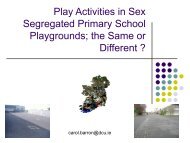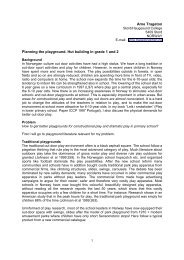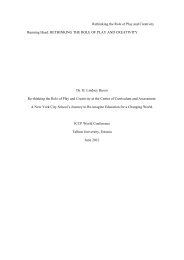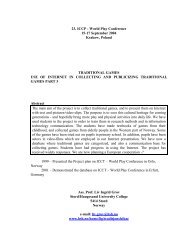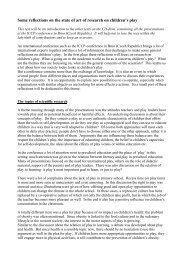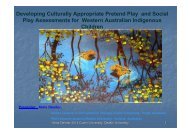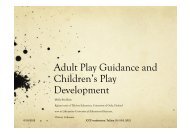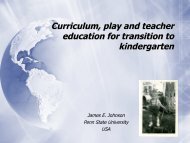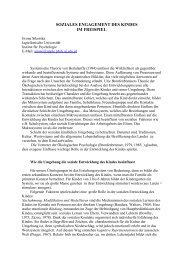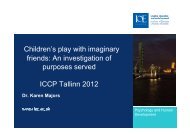References - International Council for Children's Play
References - International Council for Children's Play
References - International Council for Children's Play
Create successful ePaper yourself
Turn your PDF publications into a flip-book with our unique Google optimized e-Paper software.
Dr.sc. Mirjana Duran<br />
Teacher Training College in Osijek<br />
University J. J. Strossmayer<br />
CROATIA<br />
mirjana.duran@os.hinet.hr<br />
Traditional play in different cultures<br />
<strong>Play</strong> is an unspecialised, undifferentiated, ambiguous, multifunctional, autotelic,<br />
divergent activity and as such has a specific role in human ontogenesis. It presents the most<br />
suitable area <strong>for</strong> development and trying out of various psychic processes and human<br />
features. A child demonstrates his competence at play (mental, social, physical etc.) but he<br />
wants to experience also those activities and processes he isn't really up to yet. It is amazing<br />
how children find those games that anticipate their physical and mental development. <strong>Play</strong><br />
there<strong>for</strong>e contains, according to Vigotski (1966), all the tendencies of development, i.e. it<br />
reflects the zone of child's later development.<br />
Being a complex children's product, play carries messages about itself as a product<br />
(such as a fairy tale, myth, ritual, an image), as an externalisation of child's possibilities it<br />
carries messages about the development of psychic functions of a child, and as a part of<br />
children's subculture it carries messages about childhood and the way of growing up.<br />
<strong>Play</strong> and childhood are immanent, inseparable parts of culture and they became not<br />
only the objects of developmental psychology, but also of sociological, historical,<br />
ethnographic, cultural research. The understanding of play as a complete phenomenon<br />
requires an interdisciplinary approach. New knowledge, according to Kon (1988), emerges<br />
on boundaries of different disciplines.<br />
Every human community, every culture contains also children's subculture with its<br />
tradition, where children act as creators, mediators and transmitters. Creation, maintenance,<br />
change and transmitting of play is a sort of production of cultural products by children, i.e. a<br />
sort of child culture that children maintain and transmit within their tradition. <strong>Play</strong> is<br />
connected to all sorts of activities and experience of children groups, children beliefs,<br />
material objects made and kept by children, linguistic production etc., and all this with the<br />
tendency to be repeated from year to year.<br />
Children tradition, as well as national culture, is determined by psychological, space,<br />
time and sociological co-ordinates of the collective poetics production.<br />
As a developmental psychologist I have worked on the problem of play <strong>for</strong> over 20<br />
years (I have written two books on that subject), but ever since 1985, when I took part in the<br />
OMEP project on traditional children games, I have carried a hidden wish to explore play in<br />
different cultures. I had neither opportunity nor money to do some serious field research of<br />
play, but nevertheless I have managed to work on this problem and I would like to share<br />
some of my findings with you here.<br />
In 1983, when I read about the game LOT ANTJAK played by children of Khmer in<br />
Cambodia in Kon's Ethnography of childhood I was astonished because I played that very<br />
game with my friends when I was a child, only under a different name. But then I<br />
remembered a lot of universal elements that exist in national culture: Wheel dancing is<br />
present all over the world; the motive of dragging through a narrow passage can be found<br />
both in adult folklore and in children games all over the world; according to some data there<br />
are 345 versions of Cinderella in the world; Andrejev (according to Langer, 1967) proved by<br />
statistic analysis that the fairy-tale topics common <strong>for</strong> Russian and West-European stories<br />
make out one third of the entire index; Kirk (1970) researched the universality of myth<br />
structures in the world, and topics of myths and fairy tales similar all over the world are the<br />
object of many research; a puny, little tailor is a constant object of ridicule in the entire<br />
1 / 5
European folklore; the motive of miraculous birth is one of the most common motives in the<br />
world etc.<br />
Having researched the literature on inter-cultural research of play I concluded the<br />
following:<br />
! most authors (psychologists, ethnologists, folklorists, anthropologists) focus on<br />
differences, and not similarities of play;<br />
! there are far more comparative data on games than on symbolic play (role play),<br />
probably because games are more <strong>for</strong>mal and are there<strong>for</strong>e easier to code;<br />
! comparative data, however untrustworthy and unsystematic sometimes, indicate<br />
mostly 2 kinds of differences: differences between extremely developed communities<br />
and extremely underdeveloped ones, and differences between some undeveloped<br />
communities. There are very few data on play in developed communities, <strong>for</strong><br />
example, on play of European children;<br />
! children from more complex cultures, i.e. cultures that are technologically, socially<br />
and economically more complex, play more and in a more complex way.<br />
Bearing in mind the fact that development of community leads to creation of more<br />
complex play I ask myself: Would the present differences in child play between developed<br />
and undeveloped communities reduce (disappear) if the latter (undeveloped) reached the<br />
same technological, economic and social level of development as the <strong>for</strong>mer ones? Does<br />
play 'serve' to develop some general human developmental features or cultural<br />
particularities? In other words, what does play represent - similarities or differences among<br />
cultures? Is play similar or different among developed societies?<br />
As previously said, I did not have a possibility to explore play of different cultures. But,<br />
there are many descriptions, even collections of games and they are often used as<br />
secondary comparative sources. Even though there are many variations in game<br />
per<strong>for</strong>mance, they still have a more stable structure, are handed down from generation to<br />
generation and their recording is possible. They, in a same way as poems, stories, become<br />
the way of objectification of children tradition, they can be looked upon as finished products<br />
(on their own), as "crystals", as we do with myths, customs and rituals.<br />
On the basis of a comprehensive research condusted in Slavonia (North-Eastern region<br />
of Croatia) I identified and described ludic corpus of children of this region. Collection of<br />
games is published as an appendix of my book Child and <strong>Play</strong> 1 and contains a detailed<br />
description of 204 games.<br />
Three sources were used: in<strong>for</strong>mation obtained from children, in<strong>for</strong>mation obtained from<br />
adults, and observation and record making of children games on spots where children gather<br />
and play. These games children create independently and on their own initiative and they are<br />
"handed down from one generation to another"<br />
I compared products of children's subculture "crystallized" in such a way to children<br />
games from New Zealand and Great Britain described in collections of games Folk games of<br />
Children by B. Sutton-Smith and <strong>Play</strong> in Street and <strong>Play</strong>ground by Opie and Opie. The<br />
descriptions of games had been collected in the same three ways as ours were.<br />
The similarity of all game categories is amazing 2 . Some games are not only similar but<br />
also completely identical. This level of similarity requires psychological, but also<br />
anthropological, historical and other explanations - as it is necessary in explanation of places<br />
of all fairy tales in the world. (Only one theory proved insufficient).<br />
Folklore is, according to Prop, an international phenomenon. A problem common <strong>for</strong> all<br />
nations made us raise a question that Turner <strong>for</strong>med (1989) in this way: "...why do different<br />
groups of humans in different time and space have similar and different cultural<br />
expressions?"<br />
When I compared Croatian and New Zealand games I used the Sutton-Smith's<br />
classification; when I compared Croatian games to those from Great Britain I used the Opie<br />
and Opie's classification. In Child and <strong>Play</strong> I give my own classification. There's no time<br />
1 Dijete i igra<br />
2 All categories are in detail described in Child and <strong>Play</strong><br />
2 / 5
enough to go into this, but I would like to stress out the following: the question of<br />
classification and sorting out of the whole play manifestations are not just <strong>for</strong>mal. Just as it<br />
happens when you turn a kaleidoscope, different classification may lead to discovering new<br />
relations and characteristics. Classification is not only the result, but it's also a tool of a<br />
logical analysis a certain material is subjected to.<br />
But, let's go back to referred similarities and demonstrate them on one example (out of<br />
many). Iona and Peter Opie, describing one of the category of games they called <strong>Play</strong> of<br />
acting, asked: Why do girls in blue jeans play drama games that could have taken place on<br />
the streets of London a few centuries ago? ("A witch in the attic", "A ghost in the well" etc.)<br />
Sutton-Smith finds and describes such games in New Zealand children and calls them<br />
Dialogue games. I find them in Croatian children and call them Theatre games. Kravcov<br />
and Lazutin (1983) give descriptions of similar Russian games and they call them small<br />
theatre shows.<br />
Similar are not only the structure and fairy-tale logic, but also the dialogues.<br />
In Croatian game Skeleton children say to their mother (one child is the mother) that they<br />
are hungry and want to eat something. Mother sends them up to the attic to get some ham<br />
and sausages. Children come quickly back; they are frightened and shout: "Mother, there's<br />
something up there!" Mother com<strong>for</strong>ts and tries to reassure them. Every child that plays the<br />
role of the mother has to improvise the reassuring part. (Those are only dad's old shoes, an<br />
old broom etc.). In the end, mother is convinced in the truth of children's words and leads the<br />
following dialogue with the skeleton:<br />
Mother: "Who are you?"<br />
Skeleton: "Skeleton"<br />
Mother: "What do you sleep on?"<br />
Skeleton: "Nails."<br />
Mother: "What do you drink?"<br />
Skeleton: "Human blood."<br />
Mother: "What do you eat?"<br />
Skeleton: "Human flesh."<br />
Mother: "What time are you coming?"<br />
The skeleton whispers this in<strong>for</strong>mation to the mother, so that the children cannot hear<br />
it. The mother makes a dancing wheel with the children, the wheel turns and they all chant:<br />
"The first hour has passed, the skeleton hasn't showed, the second hour..." They keep on<br />
chanting until they come to the time the skeleton specified to come and the mother runs<br />
away. They all start running, the skeleton runs after them, children scream representing fear<br />
and the child the skeleton catches becomes the new skeleton.<br />
Sutton-Smith describes a really old game from New Zealand called Ghost in the<br />
garden. Mother sends her children to the garden, and children come back in fear, screaming<br />
and shouting: "Mother, there's a ghost in the garden." Mother com<strong>for</strong>ts and tries to reassure<br />
the children. "Those are only your dad's white underpants drying on the line." The mother is<br />
finally convinced and she has a dialogue with the ghost where she finds out that he is making<br />
a fire, to boil some water, to cook a stone, to sharpen a knife and to cut off her head. Then<br />
they all run away, screaming with fear, and the child that gets caught becomes the ghost.<br />
In the British game The old man in the well children ask their mother to give them<br />
some bread and butter. The mother looks at their hands and sees that they are dirty, so she<br />
sends them to the well to wash themselves. Children lean over the "well", scream with fear<br />
and run back to their mother complaining they saw someone in the well. The mother<br />
reassures them (improvises), <strong>for</strong> example: "Those are only your father's old underpants."<br />
Eventually, the mother is convinced in their horrible experience. The old man jumps out of<br />
the well and starts chasing the mother and children. Children scream with fear and the child<br />
caught becomes the old man.<br />
These games, as opposed to symbolic play (role play) have a relatively permanent<br />
dramatic composition. The cause <strong>for</strong> that lies in the fact that there are some basic rules that<br />
determine the course of the main events in the game. The game takes place in a linear way<br />
with the fixed succession of actions according to the "then" principle (Then this happened,<br />
3 / 5
and then this...). What we have here is a story children play more or less in a way they<br />
played it the last time. There<strong>for</strong>e the content of the game and its style become traditional. I've<br />
noticed that the compositional unity lies, the same way as in drama, most of all on the unity<br />
of speech and action. Dramatic composition develops from the introductory part that creates<br />
the conditions to develop the plot, through the middle part that develops the plot with the<br />
accelerated increase of suspense, and finishes with the last part. These games, the same<br />
way as drama, let us follow: exposition, plot, culmination, problem and disentanglement.<br />
Looking at these games as semiotic products and the way they are carried out in practice<br />
(things I paid attention to with Croatian plays) refer to thematic and structural connections<br />
with two products of national culture: fairy tale and oral national theatrology. In fairy tale<br />
topics children go through terrible experience: they come across a skeleton in the attic, the<br />
witch in the well, unknown and bad people kidnap them, parents don't believe them when<br />
they talk about their horrible experience, but the close members of their family also go<br />
through terrible things and they may easily lose them. But these games contain also topics<br />
closer to the real life, often accompanied by humour. A thief steels honey from the godfather,<br />
grandfather makes a fool of grandmother saying <strong>for</strong> example: "Run home, your cow has just<br />
had kittens."<br />
Relatively permanent dramatic composition resembles the one of the renaissance<br />
comeddie dell'arte that was based on the actors' improvisations and where they followed the<br />
course of events to only a certain degree. It also resembles the various <strong>for</strong>ms of folk<br />
theatrology where tradition and improvisation take turns.<br />
Next to the obvious delight children take in acting, we might say that juggling with the<br />
entire human repertoire <strong>for</strong> message transmission (words, gestures, face expressions,<br />
posture, breathing slowly or quickly, styled movements etc.) also has additional secondary<br />
symbolism. Children toy with their fears of the dark, loneliness, to lose the closest members<br />
of their family etc.<br />
These examples refer to one category of games, but as already mentioned, there is a<br />
striking similarity between all categories. However, some games are not only similar, they are<br />
completely identical. In Croatia children play the game of tag: Crocodile, crocodile, can we<br />
cross your golden river...? Crocodile might answer <strong>for</strong> example: "You may if you have red<br />
colour" (it refers to the clothes colour). In New Zealand this game has the name Guard the<br />
door. Children ask: "Jack, may we cross your golden river?" The answer is the same.<br />
This game spread somehow all over the world (in Croatia crocodiles can be found<br />
only in Zoos). If in 50 years someone researches children play in Croatia he or she is<br />
probably going to find many new games that children refugees brought back to Croatia from<br />
all over the world during the 90-ies. However, the question is not where the game came from,<br />
but why it was preserved in that culture.<br />
There are many didactic games teachers <strong>for</strong>ce on children, and yet they were never<br />
really accepted by them and are only used in institutions. A traditional game "Bees", on the<br />
other hand, was the first time recorded in our parts in 1958. My grandmother, my mother and<br />
I played it. It is still played on the streets of Osijek. A similar game is found in New Zealand<br />
and Great Britain. These games probably satisfy certain developmental needs of children.<br />
Durability and universality supplement each other.<br />
These days I've been corresponding with Edyta Zierkiewicz from Poland. We<br />
exchanged the predicting games, often played by schoolgirls in our countries. (These games<br />
should give answers to the following questions <strong>for</strong> example: Who are you going to marry?<br />
How many children are you going to have? What does it mean if you see a licence number<br />
with a certain combination of numbers? How much does your boyfriend love you - in<br />
percent? etc.). Croatian games have their twins in Poland.<br />
If there are some play activities in your countries join Edyta and me.<br />
And to sum up, based on everything said here so far, bearing the diversity of games<br />
in mind, I think that play is in service of that what is similar in all people, and not different.<br />
However, the play texture, which contains everything children need in order to develop and<br />
become a part of human community, possesses a lot of culturally specific symbolism as well.<br />
4 / 5
<strong>References</strong><br />
Duran, M., Mitrović, M., Plut, D. (1988). Simbolička igra i stvaralaštvo.<br />
Beograd: Zavod za udžbenike i nastavna sredstva.<br />
Duran, M. (2001). Dijete i igra. Zagreb: Naklada Slap.<br />
Kirk, G. S. (1970). Its meanings and functions in ancient and other<br />
cultures. Cambridge: Cambridge University Press.<br />
Kon, I. S., Ionova, J. V., Rešetov, A. M. (Ur.), (1983). Etnografija<br />
detstva.Moskva: Nauka.<br />
Kon, I. S. (1988). Rebenok i občestvo. Moskva: Nauka.<br />
Kravcov, I.I., Lazutin, S. G. (1983). Ruskoe ustnoe narodnoe Tvorčestvo.<br />
Moskva: "Višaja škola".<br />
Langer, S. (1967). Filozofija u novom ključu. Beograd: Prosveta.<br />
Opie, I. & Opie, P. (1969). Childrens Games in Street and <strong>Play</strong>ground.<br />
Ox<strong>for</strong>d: Ox<strong>for</strong>d univ. Press.<br />
Propp, V. (1986). Istoričeskie korni volšebnoi skazki. Leningrad:<br />
Izdatelstvo Leningradskogo universiteta.<br />
Sutton-Smith, B. (1972). The Folkgames of Children, University of Texas<br />
Press, Austin and London, 1972.<br />
Sutton- Smith, B., & Roberts, J. M. 81971). The cross-cultural and<br />
psychological study of games. <strong>International</strong> Review of Sport sociology, 6, 79-87.<br />
Turner, V. (1982). From Ritual To Theatre, The Human Seriousness of<br />
<strong>Play</strong>. New York: Copyright C by Per<strong>for</strong>ming Arts Journal Publications.<br />
Vigotski, L. S. (1966). Igra i ee rolj v psihičeskom razvitii rebenka.<br />
Voprosi psihologi, 6. 62-76.<br />
Whiting, B. B. (Ed.). (1963). Six cultures: Studies of child rearing. New<br />
York: John Wiley.<br />
Whiting, B. B. & Edwards, C. P. (1988). Children of different worlds: The<br />
<strong>for</strong>mation of social behavior. Cambridge, MA: Harvard University Press.<br />
5 / 5



